2023 stands as a transformative year in education. We have witnessed unprecedented changes and advancements driven by technology. And the numbers speak volumes. With the global EdTech market soaring to new heights, the year 2023 has seen a valuation of $121 billion. The driving force behind this meteoric rise lies in the expected CAGR of 19.1%, propelling the EdTech market to a projected $348 billion by 2031. Amidst this global transformation, North America emerged as a dominant force in the EdTech arena.
EdTech opens doors to boundless opportunities. However, it also brings to light complexities and obstacles. From issues of accessibility to concerns about data privacy, this article will delve into the nuanced aspects of the EdTech revolution. It will provide insights into the data-driven trends, unveil the statistics shaping the education sector, and address challenges that define the global educational landscape in 2023.
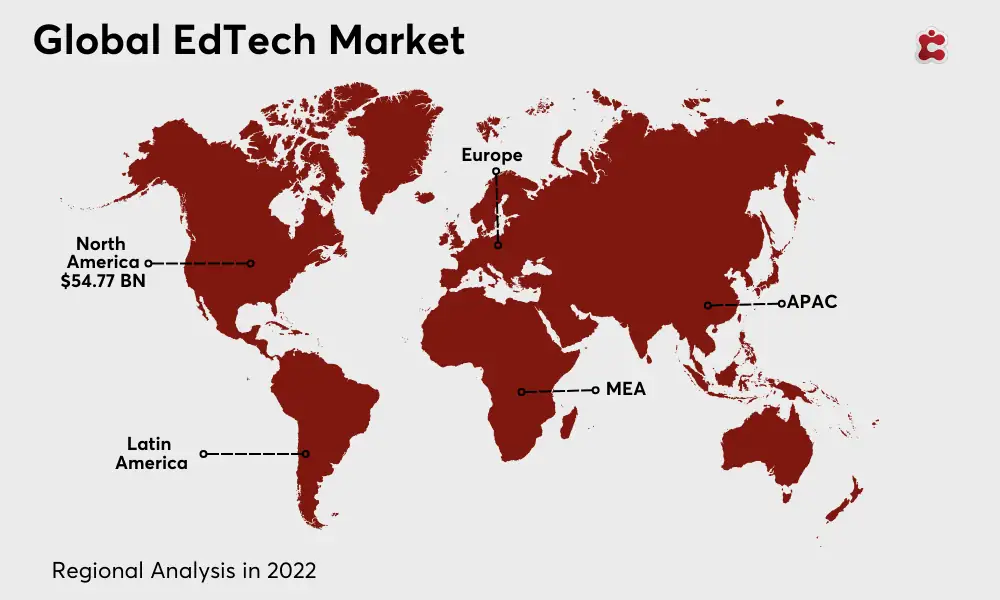
(Source market.us)
Global Trends in EdTech
The Global EdTech market represents the education technology industry dedicated to crafting innovative solutions that elevate the learning experience. Projections indicate that the market is expected to reach $696.04 billion by 2028. Notably, North America commands 36% of this market share due to considerable investments from venture capitalists. Learning Management Systems (LMS) emerge as key players, influencing global educational practices.
Digital learning tools have gained widespread adoption, reflecting a shift in pedagogical approaches. The integration of Augmented Reality (AR) and Virtual Reality (VR), gamification, mobile learning, e-learning, and personalized learning are among the notable trends driving this transformative wave.
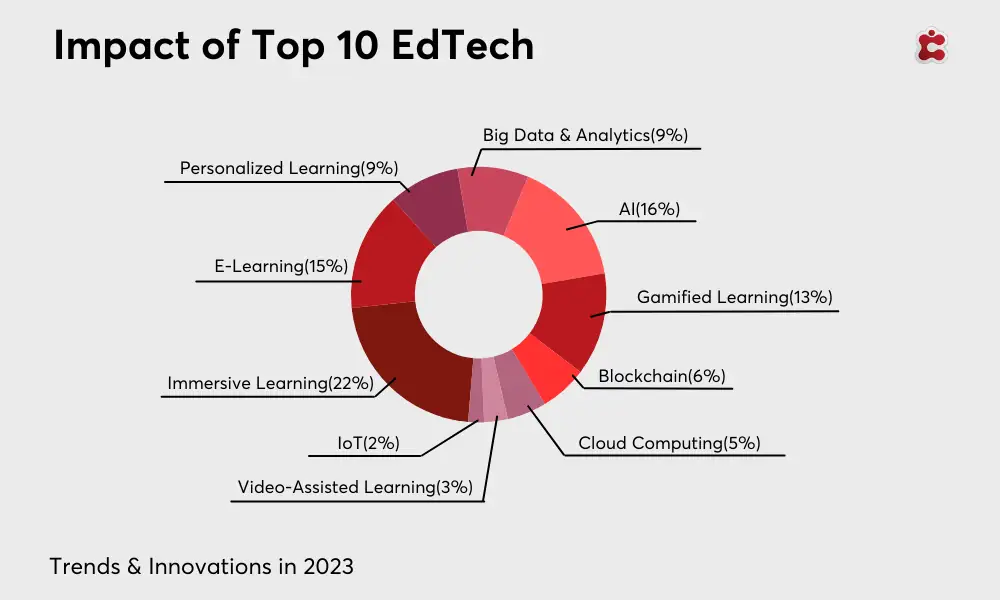
(Source startus-insights.com)
Impact of Technology
According to Global Market Insights, the global AI education market exhibited a value of $4 billion in 2022, with a projected compound annual growth rate (CAGR) of 10% from 2023 to 2030. North America currently leads in the application of AI in education, with Europe following closely, expecting to exceed growth by 15% in 2032.
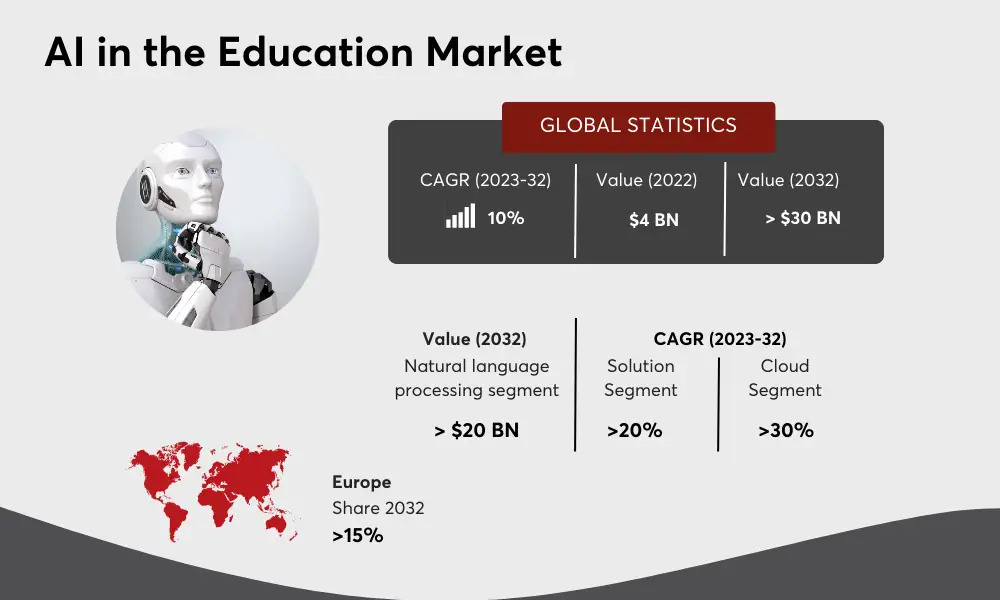
(Source gminsights.com)
The integration of AI in education opens up new possibilities for enhancing the teaching and learning experience.
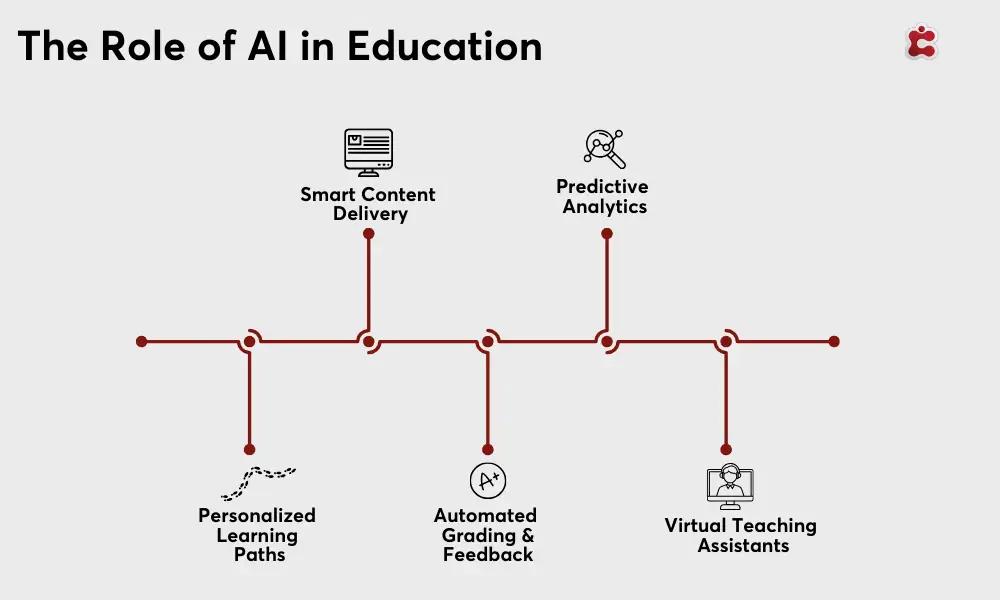
E-learning has emerged as a cornerstone in the evolution of education. Its widespread popularity is rooted in its adaptability, accessibility, and effectiveness. The projections indicate a robust trajectory for the global e-learning market, with an anticipated value of $491.35 billion by 2028. This growth is projected at a CAGR of 13.28% from 2022 to 2028.
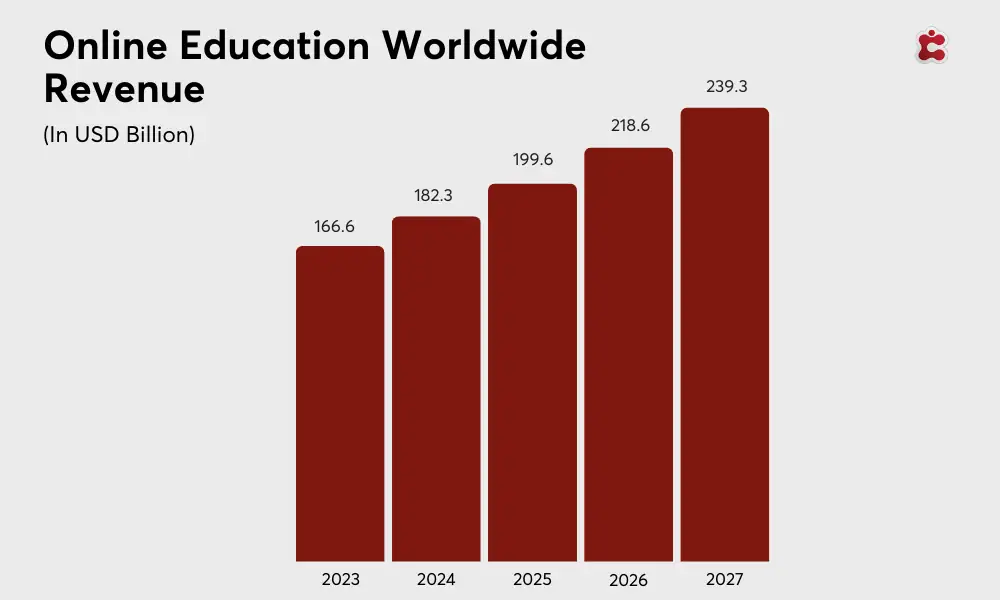
(Source: Market.us Scoop)
According to Exploding Topics, key players shaping the E-learning landscape in 2023 include:
- Coursera
- Udemy
- edX
- LinkedIn Learning
- Pluralsight
The number of students now using online learning platforms is on a continuous upswing, encompassing both graduates and adult learners seeking to enhance their skillsets for career progression. The statistics affirm the sustained growth of e-learning. It becomes increasingly apparent that this educational paradigm is not a fleeting trend but a lasting transformation. Here are the e-learning stats for 2023:
- 98% of universities moved their classes online since the COVID-19 pandemic.
- Nearly half of the Fortune 500 companies have incorporated e-learning into their business model.
- Studies show that 70% of university students agree that online learning is more beneficial than traditional in-class lessons.
- Data collected from school administrations revealed that 95% of students would recommend online education to others.
- Education through e-learning platforms produce 85% less CO2 emissions per student than campus-based learning and use 90% less energy.
- The corporate e-learning market is expected to grow by 15% between 2017 and 2026.
Educational Inequality
Despite the advances in education worldwide, a closer examination of the statistics reveals disparities in access and quality. According to UNESCO, at the tertiary level in most low- and middle-income countries, fewer than 1 in 100 adults from the poorest households achieve a bachelor’s degree. However, in wealthier households, 1 in 10 adults attain the same of level of education. Additionally, 132 million girls continue to be excluded from educational opportunities. Within the context of Sub-Saharan Africa, fewer than 40% of girls manage to complete lower secondary school.
The United States stands out as a leader in online education, boasting the highest number of learners enrolled in online courses. Statistics highlight that 19 million students enrolled in Coursera are from the U.S. Simultaneously, India and China emerged as dynamic players in the online education landscape, experiencing rapid growth.
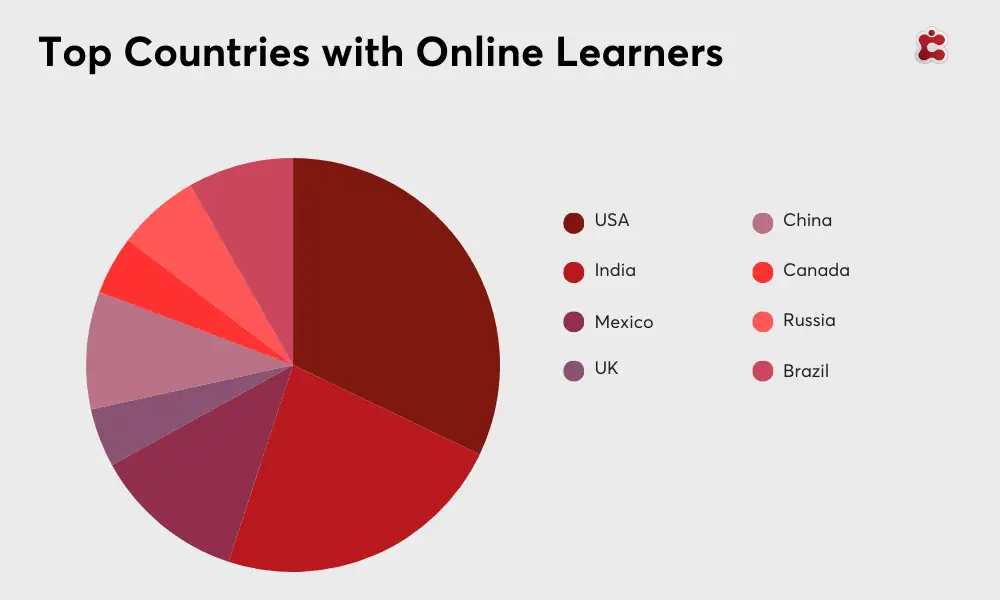
(Source UTS Online)
Demographics
The demographics of EdTech of 2023 unveils insights into the distribution of users across various age groups and gender:
- The age group of 25 to 34 years emerges as the predominant segment of EdTech users, commanding a notable 28.39% share.
- The age group of 18 to 24 years represents the next substantial cohort of EdTech users, contributing to 23.56% of the user base.
- Male users constitute 56.35% of the EdTech user base, while female users account for 43.65%.
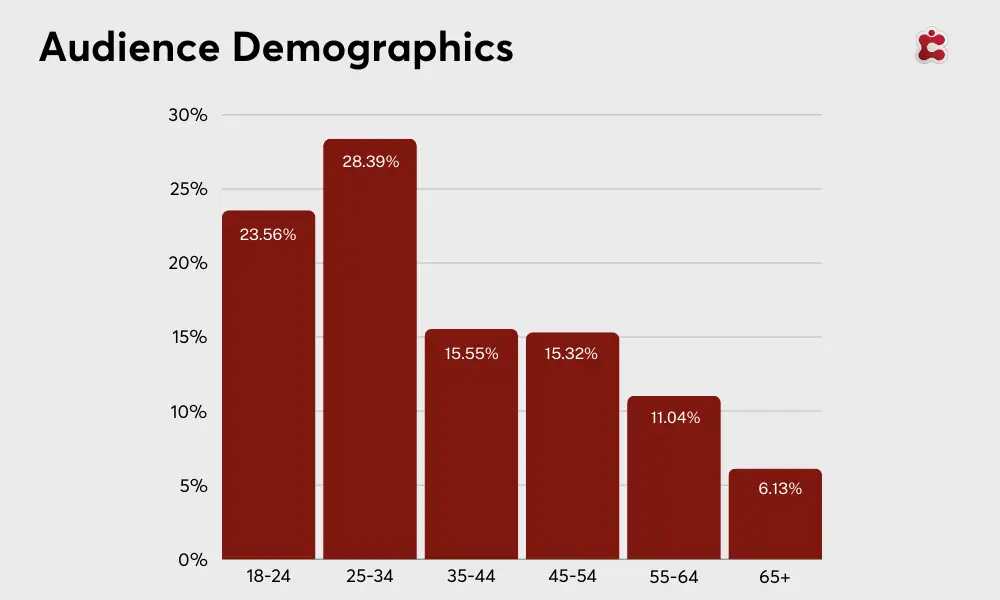
(Source: Enterprise Apps Today)
Student Performance and Outcomes
The literacy rate is defined as the percentage of individuals aged above 15 who can read and write. Across the globe, most countries boast high literacy rates, with figures surpassing 95%. However, literacy rates are notably lower in Sub-Saharan Africa and the Middle East. In these areas, some countries report rates falling below 50%, underscoring the disparity in educational opportunities. Statistical data from the EU shows that 18.5 million students enrolled in tertiary education, with 59% pursuing a bachelor’s degree.
Five countries with the highest literacy rates
| Country | Literacy Rate |
| Andorra | 100 % |
| Finland | 100 % |
| Liechtenstein | 100 % |
| Luxembourg | 100 % |
| Norway | 100 % |
Five countries with the lowest literacy rates
| Country | Literacy Rate |
| Niger | 19.10 % |
| Guinea | 30.47% |
| South Sudan | 31.98 % |
| Central African Republic | 36.75 % |
| Burkina Faso | 37.35 % |
Case Studies
The transformative power of EdTech is demonstrated in the case examined by J.P. Morgan, focusing on Latin America’s educational landscape post-COVID-19. The region grapples with a significant skills gap, talent shortages, and social dissatisfaction. Between 2020 and 2021, global EdTech ventures raised over $35 billion, with Latin America experiencing a sixfold increase in investment. Notable ventures like Coderhouse and Bedu exemplify this trend, aligning curricula with industry needs. The implementation of EdTech in Latin America yields transformative benefits:
- It helps address the significant skills gap, allowing companies to find employees with the right skill sets.
- EdTech initiatives contribute to overcoming talent shortages reported by various countries in the region, such as Argentina, Peru, Mexico, Costa Rica, and Colombia.
- The growing trend of nearshoring in Latin America necessitates technologically advanced workers. EdTech plays a crucial role in providing the necessary skills to meet the demands of higher-skill jobs.
- EdTech creates a highly competitive job market by encouraging students of all ages to develop various competencies, leading to increased demand for educational technology.
Brighteye Ventures is a leading European EdTech venture capital firm that has successfully achieved the final close of its second fund, securing €100 million in EdTech in Europe. This marks a doubling of its initial fund from 2017 and elevates its total assets under management to €150 million. The investment underscores Brighteye Ventures’ commitment to ensuring the growth of early-stage EdTech startups in Europe. Their main areas of focus include:
- Driving the growth of EdTech in Europe, particularly in countries like the UK and France.
- Emphasis on integrating cutting-edge technologies like augmented reality (AR), virtual reality (VR), and artificial intelligence (AI) into education.
- Enhancing support for portfolio companies and contribute to the broader EdTech community.
The Future of EdTech
The future of education technology promises a paradigm shift in how individuals acquire knowledge and skills. EdTech will seamlessly integrate with traditional educational models. As a result, a dynamic and personalized learning experience can be created. The focus will shift towards cultivating critical thinking, creativity, and adaptability, preparing students for a rapidly changing world. The traditional concept of classrooms will be redefined, emphasizing flexible, technology-enabled learning spaces. Bridging the digital divide will be crucial, with efforts focused on providing equal access to technology and connectivity for all students. The future of EdTech holds the promise of not only advancing learning methodologies but also serving as a powerful tool in dismantling barriers.
FAQ’s
Key trends include the integration of Learning Management Systems (LMS), digital learning tools, and the adoption of technologies like Augmented Reality (AR) and Virtual Reality (VR).
The global AI education market is valued at $4 billion in 2022, with North America leading in its application. The integration of AI enhances teaching and learning experiences.
Key players include Coursera, Udemy, edX, LinkedIn Learning, and Pluralsight, catering to students and adult learners seeking skill enhancement.






